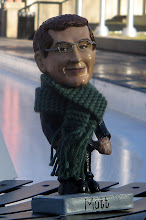This past weekend the CPO joined the Alberta Ballet for a series of performances of the Mozart Requiem. This is one of those pieces I've been waiting my whole life to play, and I hadn't envisioned my first time happening in a pit, with lots of dancers cavorting above me. Still, it was a blast to play and we got a mostly gracious review by Bob Clark in the Calgary Herald:
Requiem for the magic of Mozart's music
It might be interesting to note that, while the performance was conducted by Peter Dala, the parts were liberally marked and edited by CPO baroque series conductor Ivars Taurins. Ivars has his own language of squiggles and emphasis marks, which make his orchestral parts very distinctive. (I'll have to post a guide to Ivars' markings some time.) Since the CPO performs with Ivars all the time, we've learned to decipher all these markings, and it can streamline the rehearsal process and help everyone towards a unanimous, Ivars-approved interpretation -- even when Ivars doesn't happen to be conducting!
At one point I was rather squeamish about marking things in parts -- even changing a bowing or writing in a fingering seemed like a minor desecration, like changing the key signature or something. I've gotten way over that though, and at this point I think that well-marked parts are really the well-kept secret of great ensemble playing. Without them, we'll waste tremendous amounts of time in rehearsal, arguing over bowings and trying to correct notes. But when everything is clearly, thoughtfully marked, the orchestra can sound fantastic already at the first rehearsal. We're not hampered by all those dumb reading mistakes that poor parts can create.
Even more vitally, an orchestra's set of parts, and the markings they contain, will perpetuate a certain style and traditions of performing those pieces. Whether or not Mozart marked a rit. (or Sussmayer, or whichever other composer finished the Requiem...) we'll tend to react to a judiciously placed squiggle or backward arrow, and the conductor will have to make a point not to slow down.
In this respect the orchestra librarian is one of the most influential musicians in the orchestra, even more so than the conductor sometimes. You may be able to find his name hidden somewhere in the program, but the audience will never give a dedicated round of applause to the guy who does all that erasing, correcting, photocopying, and re-marking of parts. He'll probably never get praised in a critic's review of a performance either, even though his work can make or break that performance.
In the CPO our librarian's name is Rob Grewcock, and he definitely deserves some praise and applause.
Subscribe to:
Post Comments (Atom)


 Technorati Link Count: no. of blog reactions to this post
Technorati Link Count: no. of blog reactions to this post
2 comments:
Seriously? Grewcock? How awesome is that.
In Mexican orchestras, the vast majority of librarians are former stagehands who were simply promoted to librarian. Most can't read music, and could give a damn. Makes things more difficult than they should be sometimes.
Indeed! this is awesome..
Post a Comment